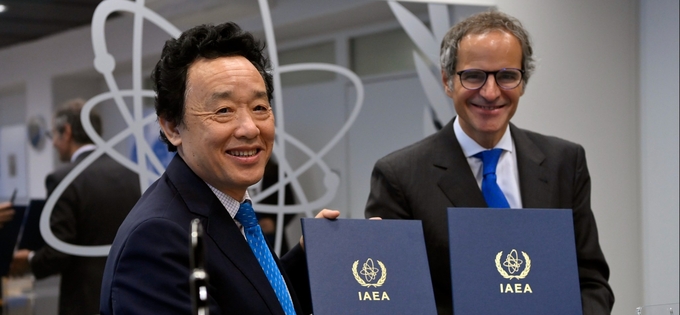May 20, 2025 | 19:52 GMT +7
May 20, 2025 | 19:52 GMT +7
Hotline: 0913.378.918
May 20, 2025 | 19:52 GMT +7
Hotline: 0913.378.918

FAO Director-General QU Dongyu, left, and IAEA DIrector-General Rafael Mariano Grossi.
Peaceful applications of nuclear science and technology can contribute to fostering crop and livestock breeds, mitigating soil erosion, and improving pest control and water management, all of which are crucial to create a better world with sustainable agriculture and food security for all.
Concrete examples range from saving water to help displaced people in Nigeria grow cucumbers to helping countries such as Algeria, Cameroon and Viet Nam, apply phytosanitary standards, enabling them to exploit their comparative advantages and export high-value fruit.
That is why the Food and Agriculture Organization of the United Nations (FAO) and the International Atomic Energy Association (IAEA) are doubling down on their commitment to significantly upgrade a collaboration that has delivered notable achievements over the past six decades.
The two United Nations agencies agreed to forge more intense collaborations today, as FAO Director-General QU Dongyu and IAEA Director-General Rafael Mariano Grossi signed a Memorandum of Understanding to leverage innovative research and development to provide enhanced and effective support for Member States and millions of people.
“Let’s work together to make full use of the Joint Centre for the benefit of farmers and consumers,” said Qu, noting that it is a very successful leading example of UN inter-agency cooperation and that FAO is mobilizing its Members to offer further support.
“For the next phase, we should work together to make our Members more aware of our joint cooperation and our services provided to them,” he added.
The agreement paves the way for the joint development of a roadmap towards a stronger strategic partnership, including joint resource mobilization and implementation of activities related to the marine environment, physical and chemical sciences and human health.
The Joint Centre
FAO and the IAEA have been close partners, running laboratories together, since 1964. “Collaboration intensified after 2007, since which time staffing of the unit grew by fourfold and, in 2020, to an institutional upgrade with the creation of the Joint FAO/IAEA Centre of Nuclear Techniques in Food and Agriculture,” said Qu Liang, who led the Centre for the past 17 years. Based in Vienna, the Centre “is a unique institution in the U.N. system, boasting advanced laboratories and carrying out sophisticated research and development activities.”
One example is the use of Cosmic Ray Neutron Sensors to monitor landscape soil moisture, contributing to improved land management and optimized climate-smart food and agricultural output. The sensors are able to detect moisture tens of centimeters beneath a surface and can fill the gap between point soil moisture readings and the large-scale data provided by remote sensing.
Vaccines are another important area of work. The IAEA helped develop the vaccine for the FAO-led campaign to eradicate Rinderpest, a cattle plague that is one of only two – the other was smallpox eliminations of a deadly virus. Today the Center is developing irradiated vaccines for livestock in Ethiopia, which exports more than one million head of cattle each year, that can inactivate pathogenic microorganisms in livestock, so that the animals avoid disease and also the risk of vaccination with a live microorganism.
Another major initiative of the Joint Centre is developing ways to leverage the plant microbiome of bananas and plantains to allow them to fight off Fusarium wilt disease, a major menace for banana production on which more than 400 million people rely for income.
Because atoms contain highly specific signatures, their isotopic analysis can help identify the origin of unwanted environmental vectors. After numerous successful projects focused on soil erosion, the Centre is now researching microplastics using nuclear techniques. This could provide incisive support for efforts to reduce plastic pollution, on land and in the sea, which has important adverse impacts on climate and environmental patterns.
Other exciting themes to which nuclear technologies can contribute are in the realms of food safety, phytosanitary standards required for trade, and origin tracing of specialty products to combat food fraud.
As is more widely known, the Joint Centre is the vanguard player in the growing use of the Sterile Insect Technology, in which millions of radiation-sterilized Mediterranean fruit flies and other pests are released to engineer declines in the wild population of pests that can destroy market access for fruits and vegetables.
The laboratories
Qu and Grossi, along with senior officers from both FAO and IAEA, toured the Joint Centre’s laboratories – units focused respectively on Plant Breeding and Genetics, Insect Pest Control, Food Safety and Control, Soil and Water Management and Crop Nutrition, and Animal Production and Health- in Seibersdorf, Austria on Monday.
Qu emphasized that the Joint Centre’s programme and activities are “demand-driven and problem-oriented” with a focus on transferring technologies to allow Member States to respond to real, practical needs. “The technological achievements of the Centre have an impact on the entire supply chain from farmers and producers to consumers, from the lab to the field and kitchen,” he said.
(FAO.org)

(VAN) Attempts to bring down the price of the Japanese staple have had little effect amid a cost-of-living crisis.

(VAN) Fourth most important food crop in peril as Latin America and Caribbean suffer from slow-onset climate disaster.

(VAN) Shifting market dynamics and the noise around new legislation has propelled Trouw Nutrition’s research around early life nutrition in poultry. Today, it continues to be a key area of research.

(VAN) India is concerned about its food security and the livelihoods of its farmers if more US food imports are allowed.

(VAN) FAO's Director-General emphasises the need to work together to transform agrifood systems.

(VAN) Europe is facing its worst outbreak of foot-and-mouth since the start of the century.

(VAN) The central authorities, in early April, released a 10-year plan for rural vitalization.